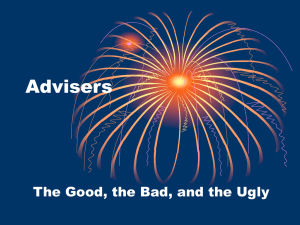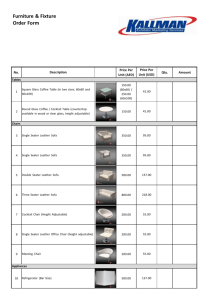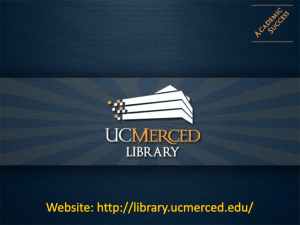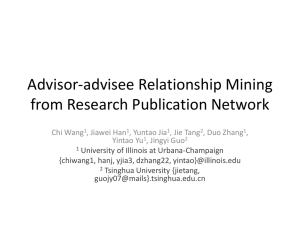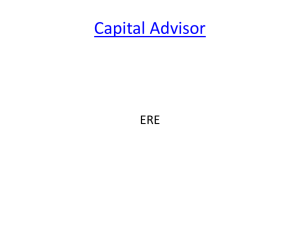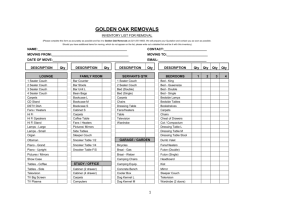School Evaluation Greece
advertisement
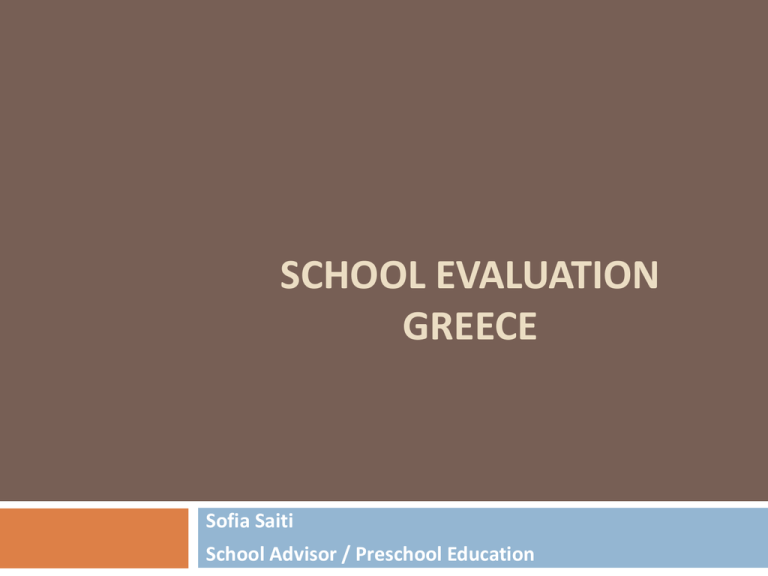
SCHOOL EVALUATION GREECE Sofia Saiti School Advisor / Preschool Education Structure of the Greek Education System 2012/13 Organisational Structure of the Ministry of Education and Religious Affairs, Culture and Sports. Ministry of Education and Religious Affairs, Culture and Sports Regional Education Directorates (13) Directorates of Education (Prefecture) Schools Teacher’s teaching hours per week (Primary) 2517/1997 25 hours ( in 1, 2 or 3 seater schools) 24 (0-10 years) 23 (10 - 15 years) 22 (15 - 20 years) 21 (20 & more years) 20 (headmasters in 4 or 5 seater schools) 12 (headmasters in 6 or 8 seater schools) 10 (headmasters in 10 or 11 seater schools) 8 (headmasters in 12 & more seater schools) Responsibilities of the school advisor Supervision Observation Peer teaching Mentoring, supporting – pedagogical work Training Coordination, planning, program development, surveys, educational studies, Reporting (end of school year)-points out weaknesses, difficulties, proposes ways of improvement Educational reform New curricula (pilot implementation). upgrade of all-day school Establishment of the Institute of Educational Policy (IEP) (scientific, executive body of the Ministry of Education which has an advisory and supportive role as far as the designing and imlementation of educational policy issues on primary and secondary education are concerned and on 4 pilars: Curricula, Evaluation, Training, Research) Reformed induction programme for newly appointed teachers (app.100h divided into 3 phases) School self – evaluation (2010-12 pilot implementation) School advisor’s training – certificate of “guidance competency” In this context, the educational reform cultivates the practice of evaluation and feedback in order to identify potential areas for change and improvement. Evaluation of educational work Constitutes a major educational issue. 1982, the institution of the ‘inspector’ was substituted by the school advisor Lack of assessment since then. Lack of assessment culture The state has at times attended to pass laws that yet remained nugatory. The passage of the last law 3848/2010 on the selfassessment of educational work (AEE) has tried to establish the view that assessment consists an important scientific field of education with major sociopolitical dimensions Self - assessement of educational work Evaluation School Improvement Effectiveness Reflection / Feedback Supervision Internal evaluation (1) - primary and secondary education Both external and internal evaluation are included in the law (ν. 3848/2010, 4142/2013) - teachers’ evaluation has n’t taken its final form yet. Project of Institution of Educational Policy Pilot self-assessment of school units was applied to a number of schools who accepted (550) and the procedure lasted for 2 years. (total number 2010-2011: Preschool: 6067, primary: 5377) It is conducted once a year by the headmaster and the educational staff of each school, in cooperation with the school advisor and in some cases with the parents and students as well. Steps / Phases First Year Initial assessment of the overall profile (outlook) of the school Mutually acceptable goals and priorities Developing action research in school Selection, planning and organization of action plans (projects) Submission of the annual self-assessment report. Second Year Realization of the action plans (projects) Utilization (exploitation), of results Submission of the annual selfassessment report Results published on the school website and on the Hellenic School Networ (Use of the Observatory (Centre) of AEE.) Networking with other schools and dissemination of good practices) Tools / Sources for data collection Teachers calendar Photos Videotaping of teaching acts Interviews with students and parents Observation forms Questionnaires / Socialgram Teachers‘ meetings (minutes) Records from the meetings with parents Students Data bases (e-school) Subjects content Comments/Views of all involved Curriculla guide SCHOOL IDENTITY Social and civil characteristics of students and school Α. DATA Sectors 1. Means & Funds Indexes School room, materials, hardware and financial resources Staff Β. PROCEDURES Sectors 2. Leadership, Management and Organization of School Indexes Management & Coordination of School Life Resource Management Support and development of human resources 3. Teaching & Learning 3.1 Development and implementation of teaching practices 3.2.Development & implementation of pedagogical practices and assessment practices of students 4. Atmosphere and 4.1Relations between teachers-students and between students relations at school 4.2. School and parents relations and partnerships with teachers - social actors 5.Programs, interventions and improvement actions 5.1 Educational programs and innovations, supportive and compensatory interventions C. OUTCOMES Sectors 6.Educational Outcomes Indexes 6.1 Students attendance – leak 6.2 Students achievements and progress 6.3 Personal and social development of students 7. School outcomes 7.1 Fulfilling school objectives «Authority for Quality Assurance in Primary and Secondary Education» Independed administrative (established (4142/ 9-4-13). It consists of a Department of a scientific personnel of 25 and administrative of 10 It will evaluate the quality of the school units self – assessment and other entities’ work which are being supervised by the Ministry of Education and the teachers’ evaluation process as well, with main purpose to ensure the validity, the trustworthiness and the objectivity of the evaluation process (every 4 years) One or more committee of 5 experts will be established in each Directorate of Education which will supervise the evaluation process. Thank you Ευχαριστώ Sofia Saiti Primary School Advisor Greece – Hepirus sofiasait@yahoo.gr


